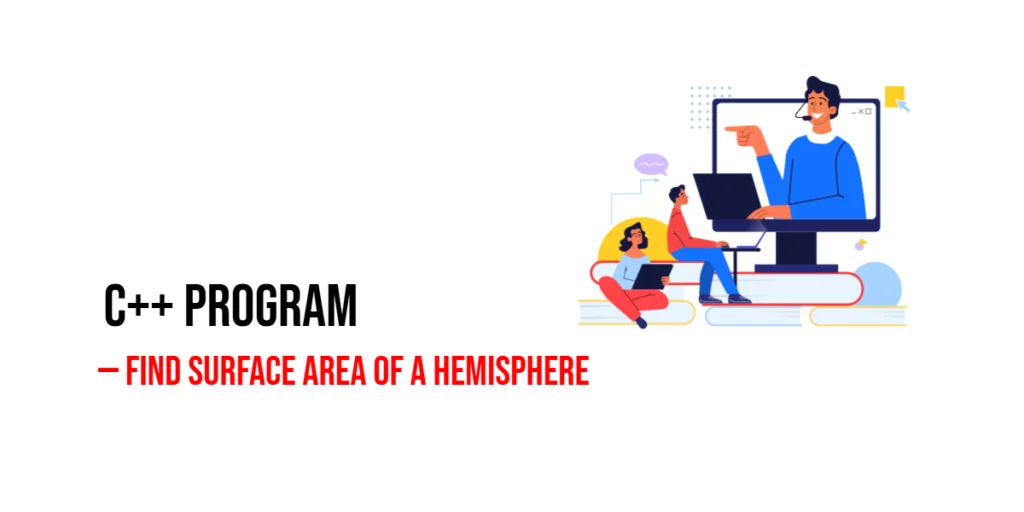A hemisphere is half of a sphere and appears in many practical applications, from domed structures to science models. Calculating its surface area is useful in engineering, architecture, and physics. Learning to compute the surface area in C++ helps beginners practice formulas, arithmetic operations, input handling, and functions, while connecting programming to real-world problems.

with hands-on learning.
get the skills and confidence to land your next move.
Program 1: Surface Area Using User Input
This program calculates the surface area of a hemisphere by asking the user to input the radius. It demonstrates how to use basic arithmetic and constants to find the total surface area.
#include <iostream>
#include <cmath>
using namespace std;
int main() {
double radius, surfaceArea;
cout << "Enter the radius of the hemisphere: " << endl;
cin >> radius;
// Total surface area = curved surface + base area = 3 * M_PI * r^2
surfaceArea = 3 * M_PI * radius * radius;
cout << "The surface area of the hemisphere is: " << surfaceArea << endl;
return 0;
}The program uses the formula 3 * π * r² to calculate the total surface area of a hemisphere, including its flat circular base. Beginners can see how mathematical formulas are translated directly into C++ code and how input/output operations work.
Program 2: Surface Area Using Predefined Radius
Sometimes, it is helpful to calculate surface area quickly without asking the user. This program uses a predefined radius to demonstrate the calculation.
#include <iostream>
#include <cmath>
using namespace std;
int main() {
double radius = 5.0;
double surfaceArea = 3 * M_PI * radius * radius;
cout << "For a hemisphere with radius " << radius
<< ", the surface area is: " << surfaceArea << endl;
return 0;
}Using predefined values allows beginners to experiment and see how different radii affect the surface area. It reinforces understanding of formulas, constants, and arithmetic operations.
Program 3: Using a Function for Surface Area Calculation
Encapsulating the surface area formula inside a function makes the code reusable and easier to read. This approach is useful when calculating surface areas for multiple hemispheres or in different parts of a program.
#include <iostream>
#include <cmath>
using namespace std;
double calculateSurfaceArea(double radius) {
return 3 * M_PI * radius * radius;
}
int main() {
double radius;
cout << "Enter the radius of the hemisphere: " << endl;
cin >> radius;
double surfaceArea = calculateSurfaceArea(radius);
cout << "The surface area of the hemisphere is: " << surfaceArea << endl;
return 0;
}Functions help beginners separate logic from input/output, making the program modular and easier to maintain. This also encourages reusable and clean coding practices in C++.
Program 4: Surface Area for Multiple Hemispheres Using Arrays
For scenarios where multiple hemispheres are involved, arrays and loops allow efficient calculation of surface areas for several radii at once.
#include <iostream>
#include <cmath>
using namespace std;
int main() {
double radii[] {2.0, 4.0, 6.0};
int n = 3;
for(int i = 0; i < n; i++) {
double surfaceArea = 3 * M_PI * radii[i] * radii[i];
cout << "Hemisphere " << i+1 << " -> Surface Area: " << surfaceArea << endl;
}
return 0;
}Using arrays and loops teaches beginners how to handle multiple values efficiently and automate repetitive calculations. This method is particularly useful for scientific computations or large datasets.
Frequently Asked Questions (FAQ)
Q1: Can integers be used for the radius?
Yes, but using double ensures more precise results for fractional radii.
Q2: Why use a function instead of direct calculation?
Functions make the code reusable, cleaner, and easier to maintain.
Q3: How is the total surface area formula derived?
The total surface area is the sum of the curved surface area (2πr²) and the base area (πr²), giving 3πr².
Q4: Can arrays be used for user input instead of predefined values?
Yes, arrays can store user-input radii, allowing multiple calculations efficiently.
Conclusion
Calculating the surface area of a hemisphere in C++ is an excellent way for beginners to learn formulas, arithmetic, loops, arrays, and functions. Starting with user input and predefined values, and then moving to functions and arrays, helps learners understand both geometry and coding principles. Practicing these programs builds confidence and prepares beginners for more advanced mathematical and programming challenges.
Additional & References
To continue learning, beginners should practice functions, loops, and arrays with other 3D shapes like spheres, cones, and cylinders. Trying different approaches strengthens coding skills and conceptual understanding.
- C++ Functions – Learn how to create reusable functions.
- C++ Arrays – Guide for handling multiple values efficiently.
- C++ Input/Output – Reference for handling user input and output.
- Programiz C++ Tutorials – Beginner-friendly tutorials on loops, functions, and arithmetic operations.







